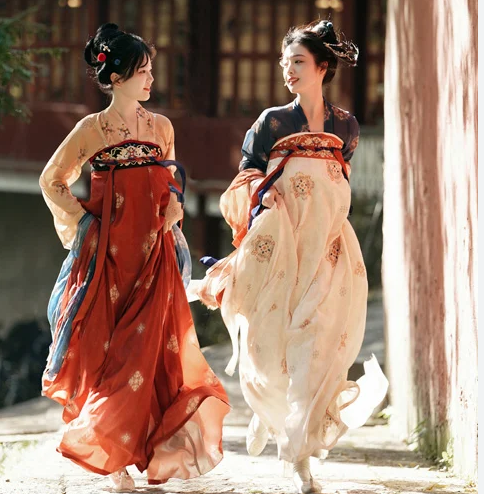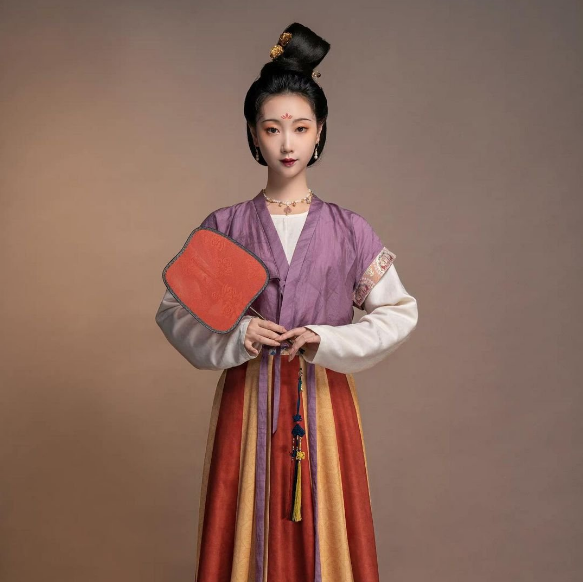Initially, Tang Dynasty Hanfu had simpler designs; mid-Tang featured vibrant, voluminous styles, while late Tang saw more relaxed, diverse forms.
Main Historical Context of the Tang Dynasty
Overview of the Tang Dynasty Era
The Tang Dynasty, spanning from 618 to 907 AD, marked a golden age in Chinese history. It began when Emperor Gaozu seized the throne, ushering in a period of unprecedented development. Under the Tang, China’s territory expanded, reaching its zenith in terms of political power and geographical extent. Notably, the reign of Emperor Taizong saw the consolidation of this power, establishing a governance model revered in later periods. The Tang era was distinguished by its robust bureaucracy, which followed a structured imperial examination system. This system democratized the bureaucracy, allowing talent and knowledge to determine one’s position, a significant departure from the aristocracy-based systems of previous dynasties.

Cultural and Economic Prosperity in Tang China
Tang China thrived economically and culturally, becoming one of the world’s largest urban centers. Chang’an, the capital, was a cosmopolitan hub, bustling with trade and cultural exchange. The Silk Road, a network of trade routes, linked China with the Middle East, Europe, and Africa, facilitating an era of economic prosperity. This period witnessed a flourishing of arts and literature, with poets like Li Bai and Du Fu, whose works remain cornerstones of Chinese literature. The Tang Dynasty also saw significant advancements in science and technology, including innovations in medicine, engineering, and astronomy.
Influence of Foreign Cultures on Tang Society
Tang society was remarkably open to foreign influences, which is evident in its art, literature, and fashion. The Silk Road played a crucial role in this cultural exchange, introducing new ideas, religions, and customs. Buddhism, originating from India, reached its zenith in China during this era, profoundly influencing Chinese spirituality, philosophy, and art. The Tang capital, Chang’an, attracted scholars, traders, and monks from across Asia, making it a melting pot of diverse cultures. This multicultural environment significantly impacted the evolution of Hanfu, the traditional Chinese attire, as it began to incorporate elements from these varied cultures, reflecting the dynasty’s cosmopolitan nature.
Main Early Tang Dynasty Hanfu Styles
Characteristics of Early Tang Fashion
Early Tang fashion was a testament to the dynasty’s opulence and openness. Distinctive for its brightness and elegance, Hanfu during this period often featured flowing robes known as “shenyi.” These were long, wide-sleeved garments that draped gracefully. Color played a pivotal role, with vibrant hues like crimson, emerald, and sapphire dominating the palette. Silk, owing to China’s mastery in sericulture, was the predominant fabric, renowned for its smooth texture and luster. Embroidery, incorporating gold and silver threads, added a touch of extravagance, often depicting mythical creatures or auspicious symbols.
Differences from Preceding Dynasties
The evolution of Hanfu from preceding dynasties to the early Tang period was marked by significant changes. Here is a comparative table highlighting these differences:
| Aspect | Pre-Tang Dynasties | Early Tang Dynasty |
|---|---|---|
| Silhouette | More form-fitting, less flowy | Wider, more flowing robes |
| Sleeves | Relatively narrow | Wider and more elaborate |
| Color Palette | More subdued hues | Bright, vibrant colors |
| Fabric | Predominantly silk but less refined | Higher quality silk, more lustrous |
| Embroidery | Less intricate | More elaborate with gold and silver threads |
| Cultural Influences | Mainly traditional Chinese | Diverse, incorporating foreign elements |
This table illustrates how Tang fashion not only evolved from its historical precedents but also set new trends, reflecting the dynasty’s prosperity and cultural diversity.
Influence of Gender and Social Class on Fashion
In early Tang fashion, gender and social class significantly influenced clothing styles. Men typically wore robes that were shorter and more practical, reflecting their roles in society. Women’s attire, on the other hand, was more elaborate, often comprising multiple layers and accessories. Nobility flaunted their status through luxurious fabrics and intricate designs, while commoners wore simpler, more utilitarian garments. This distinction in fashion underscored the hierarchical nature of Tang society. Women’s fashion, in particular, saw remarkable diversification during this period, with the introduction of high-waisted dresses and skirts, a departure from the more uniform styles of previous dynasties. This diversification not only mirrored the evolving societal roles of women but also underscored the Tang Dynasty’s broader cultural shifts.
Main Mid-Tang Evolution of Hanfu
Introduction of New Fabrics and Patterns
During the mid-Tang period, the Hanfu experienced a significant evolution in terms of fabrics and patterns. Silk remained a popular choice, but weavers began experimenting with blends, incorporating cotton and wool, which were less expensive and more accessible to the general populace. The introduction of new dyeing techniques led to an even richer color palette. Patterns became more intricate and symbolic, often featuring natural elements like flowers and birds, which were deeply rooted in Chinese cultural motifs. These changes reflected advancements in textile technology and a growing economy that could support more diversity in fabric production and design.
Changes in Hanfu Silhouettes and Designs
The mid-Tang era witnessed notable changes in the silhouettes and designs of Hanfu. Garments became more tailored and fitted compared to the earlier, looser styles. A significant innovation was the introduction of the ‘Beizi’, a long jacket-like garment that offered more versatility in styling. Women’s dresses saw a transformation with higher waistlines and narrower sleeves, a style that emphasized elegance and grace. This period also marked the advent of layered clothing, allowing for more complex and varied outfits that indicated the wearer’s social status and fashion sensibility.
Cross-Cultural Influences on Mid-Tang
The mid-Tang Dynasty, a peak period for the Silk Road trade, welcomed profound cross-cultural influences in fashion. Contact with Central Asian and Persian cultures introduced new styles and motifs into Hanfu. Clothing began to feature elements like stand-up collars and structured bodices, borrowed from foreign dress styles. These influences were not just aesthetic but also functional, as they often incorporated elements better suited to different climates and lifestyles. This blend of domestic and foreign fashion elements showcased the cosmopolitan nature of Tang society and its openness to external influences.

Main Late Tang Dynasty
Integration of Diverse Cultural Elements in Hanfu
In the late Tang Dynasty, Hanfu became a canvas for cultural synthesis. Influences from various parts of the Silk Road, especially Central Asia and Persia, became more pronounced. New fabrics like damask and gauze, previously rare, became popular. Patterns started featuring more exotic motifs, such as lions and peacocks, which were not traditionally found in Chinese iconography. This integration reflected the Tang’s extensive trade networks and their encounters with diverse cultures. Interestingly, this era also saw the incorporation of Buddhist and Taoist symbols into clothing, signifying the deep spiritual and philosophical impact of these religions on everyday life.
Adaptation to Changing Social Norms and Lifestyles
The late Tang Dynasty was a time of significant social transformation, which was mirrored in the evolution of Hanfu. The increasing power and visibility of women in society led to more practical and varied styles in women’s clothing. For instance, skirts became shorter and jackets more fitted, catering to the needs of more active lifestyles. This period also saw a relaxation of the strict dress codes that had earlier defined the Hanfu, with commoners beginning to adopt styles and fabrics that were once exclusive to the nobility. Such changes indicate a society in flux, moving towards more practicality and breaking away from the rigid class distinctions of the past.
The late Tang Dynasty’s approach to fashion, with its blend of traditional Chinese elements and foreign influences, and its adaptation to changing societal norms, set the stage for the dynamic evolution of Chinese clothing in subsequent dynasties.